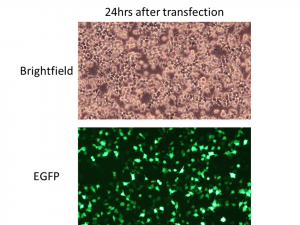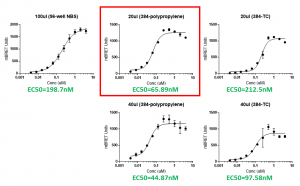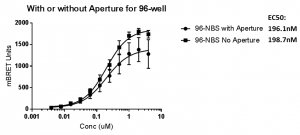In nanoBRET assay, a fluorescently labelled tracer binds to the ATP-binding pocket of ACVR1/ALK2. This binding brings the tracer into the proximity (<10nm) of Nano-Luciferase which is fused to the C-terminus of ACVR1/ALK2. Bioluminescence resonance energy transfer (BRET) occurs where the energy released by Nano-Luciferase is transferred to the fluorophore via intermolecular forces. Nano-Luciferase and tracer emit light at 460nm and 610nm respectively. The amount of tracer bound to ACVR1/ALK2 will be proportional to BRET signal (610nm light). The direct engagement of compound molecules to ACVR1/ALK2 can be determined from the reduction in BRET signal.
Matt Robers and Jim Vasta from Promega had provided us with Tracer-6908 that was developed collaboratively with SGC. Before the tracer can be used in nanoBRET assay for compound IC50, it is necessary to determine the optimal tracer concentration. The tracer concentration needs to be sufficient to produce adequate BRET signal while at the same time low enough to not obscure the competition by test compounds.

The transfection efficiency is good enough for the experiment to be carried forward
To my surprise, the EC50 of Tracer-6908 with ACVR1/ALK2-c-nanoLuc differs depending on the microplate used and assay volume. In the future, assay condition must be unified for the results to be comparable between compounds tested.

The condition and assay volume chosen for future compound tests is bracketed in red
Another practical lesson learned is that care must be taken when acquiring BRET measurements with aperture “spoon” installed on the reader machine. The 96-well microplate BRET measurements acquired with 384-well aperture “spoon” contained large standard deviation. Removal of the aperture “spoon” drastically reduced the standard deviation, with minimal change to the EC50 value estimated from the curve.

Blotting out signal unnecessarily might result in large standard deviations
From this experiment, 20ul assay volume in 384-well polypropylene microplate was chosen for ACVR1/ALK2 nanoBRET assays in the future because it will be most cost efficient (I am cutting the cost approximately from £45 to £10 per compound per assay!). In this setting, the EC50 of Tracer-6908 is 65nM.
For experimental details, please refer to Zenodo.

One Reply to “Determining the EC50 of Tracer-6908 with ACVR1/ALK2-NanoLuc”